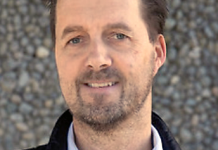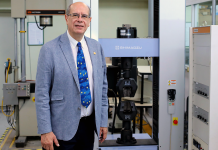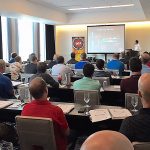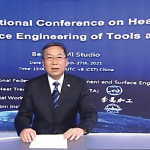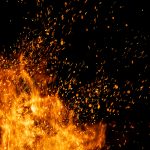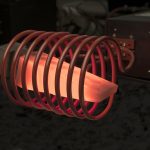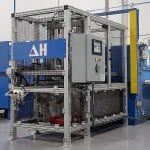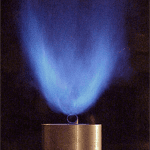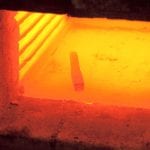Quality of leadership matters – at all employee levels
Leadership isn’t always about the top management directing the way for the company. Leadership can be found at all levels of the company in...
An overview of insulating firebricks
Ceramic refractory materials are useful for the following functions:
1. Serving as a thermal barrier between a hot medium and the wall of a...
Thermal separation of polyalkylene glycol quenchants
Polyalkylene glycol quenchants are used in a variety of different heat-treating applications. One very common application is quenching of large steel and aluminum components....
IHEA fall seminars return to Cleveland, Ohio
The Industrial Heating Equipment Association (IHEA) heads back to Cleveland, Ohio, for its 2021 Fall Seminars and Tabletop Exhibition. The Combustion Seminar and the...
Good habits, a solid system can help avoid mistakes
The contract is the first piece of paper you receive with incoming parts prior to processing. This is the purchase order (PO) that details...
IHEA announces its 2021 annual meeting
The Industrial Heating Equipment Association (IHEA) is ready to deliver a safe and healthy environment for its 2021 Annual Meeting, scheduled for July 26-28,...
Heat treatment of aluminum Part VII – Hardness and conductivity
In the previous article, we discussed the artificial aging of aluminum. Once we have heat treated the parts, we need to verify the properties....
Predicting strains key to evaluating heat-treat response
Quench hardening of steel components requires the components to be heated to a temperature such that the solid-state crystal structure of the material changes...
Q&A with Turgay Ozan
Busch Vacuum Solutions USA, one of the largest manufacturers of vacuum pumps, blowers, compressors, and systems, has acquired Jennings Associates Inc., a distributor for...
4th International Conference on HTSE of Tools and Dies successfully held online
This first online global IFHTSE conference was hosted by member China Heat Treatment Industry Association (CHTA) and co-organized by Harbin Institute of Technology and...
IHEA offers 2021 Virtual Spring Safety Standards & Codes Seminar
After the success of a series of virtual seminars last fall, the Industrial Heating Equipment Association (IHEA) has scheduled a virtual Safety Standards &...
Q&A with Andrew Bassett
You recently launched your Aerospace Compliance Software. How does it work?
Aerospace Compliance Software is a brainchild of ours. The software eliminates human errors of...
Heat treatment of aluminum VI – Artificial aging
In the previous column, we described the fundamentals of natural aging. In natural aging, the solid solution obtained after quenching starts to form precipitates...
Zoltán Koloszváry appointed honorary president of IFHTSE
For the first time in 30 years, IFHTSE has appointed an honorary president. Honorary presidents have rendered outstanding and continuous service to the Federation...
Heat treating from the operator’s perspective
Often, a customer visit involves a walk through the facility. Comments are made about how clean it is or how well organized a process...
An overview of refractory ceramic fibers
This article will review refractory ceramic fibers (RCFs), which are amorphous, inorganic, man-made aluminosilicate fibers. RCFs belong to a class of materials termed man-made...
When different processes co-exist
I’m a quality director at Byington Steel Treating, Inc. (BST). We are a commercial heat-treat shop with accreditation to perform NADCAP/AMS (aerospace) processes. Similar...
Ambrell has been all about induction heating since 1986
Established in 1986, the Rochester, New York-based IHEA member manufactures a range of induction heating solutions. The company has steadily grown from a small...
Heat treatment of aluminum, Part V
After quenching and any straightening, the supersaturated solid solution of aluminum wants to reach equilibrium. It does this through the process of precipitation hardening....
Accounting for carbon rejection can head off trouble
The heat treatment of steel alloys is required in almost every industry to acquire the necessary properties for a material given a particular application....
Q&A with John Niggle
What’s a typical week like for you at Pelican Wire?
Pelican is a custom wire manufacturer, and for that reason, it is a little difficult...
Q&A with Stephen Harris
Tell us about the new Bodycote Elgin, Illinois, facility. When did it become fully operational?
We are very pleased to announce that our brand-new Elgin...
Heat treatment of aluminum IV: Handling distortion
After quenching, depending on the quenchant used, distortion of parts can occur. This is particularly true for water-quenched parts. Parts must be straightened. This...
Tailoring advanced ceramics to meet niche properties
Ceramics are traditionally described as inorganic, nonmetallic solids that are prepared from powdered raw materials and fabricated into products through the application of heat....
IHEA educates the industry in person, online
Looking ahead … Register now!
Fundamentals of Industrial Process Heating
Winter Online Course
January 25–March 7, 2021
IHEA’s Fundamentals of Industrial Process Heating Online Learning Course has been...
Heat treatment of aluminum, quenching Part III
In the last article, we discussed quenching of aluminum, and the importance of rapid quenching to prevent the formation of precipitates at the grain...
Get to know IHEA’s new member: DELTA H TECHNOLOGIES
IHEA’s newest member, DELTA H TECHNOLOGIES, is a growing family business that prides itself on quality and performance. The company was originally established as...
‘Say what you do, do what you say’
In the special process world of the aerospace industry, companies with requirements of aerospace manufacturing must rely on the accreditation of AS9100 and the...
Q&A with Andrew Storey
What’s a typical week like for you?
I’m the technical person who works on a specific group of products on the sales side of...
Evaluating a material’s response during austenitization
Carbon content in steel has a direct correlation to the hardness and overall strength of a component after heat treatment. Carbon can take many...
Q&A with Trevor Jones
As a quick refresher, remind our readers of Solar Manufacturing’s role in the heat-treat industry?
Solar Manufacturing is a premier vacuum furnace manufacturer that specializes...
Q&A with Shlok Sundaresh
What is your role at TS USA?
I joined TS USA, HEF Group, in 2014 as a process engineer for its Springfield, Ohio, facility. As...
Heat treatment of aluminum, part II: Water quenching
In the last article, we talked about the metallurgy behind quenching aluminum. Now we are going to discuss the available quenchants for aluminum.
Introduction
To achieve...
IHEA’s 2020 fall combustion and safety seminars go virtual
Each fall, the Industrial Heating Equipment Association (IHEA) brings industrial process heating professionals together to provide combustion and safety education for the industry. This...
AMS2750F contains key pyrometric changes
By now, most heat treaters should have had some time to read the new revision of AMS2750. The changes are extensive and, since it...
Modeling can improve press quenching process
A combination of carburization and quench hardening is often used to increase the strength and improve fatigue performance of steel parts. During quenching, stresses...
Q&A with Tom Morrison
When did you make the decision to take FNA virtual?
Our Executive Committee has been meeting weekly since April when COVID-19 really started to take...
Heat treatment of aluminum – Part I: Quenching basics
In previous articles, we discussed the role of alloying elements and discussed the solution heat treatment of aluminum. We showed that it is important...
AMS2750 pyrometry revisions tweak a crucial process
AMS2750 pyrometry is a daunting heat-treat special process requirement in the aerospace industry. It’s a literal definition implying measurement of temperature, but it also...
Check out IHEA webinars, online education
IHEA strives to provide a base of industry knowledge for our members and users in the industrial process heating industry. Many valuable resources can...


